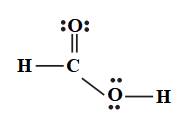
Concept explainers
(a)
Interpretation:
The Lewis structure of
Concept introduction:
The strategy for drawing Lewis structure is mention below.
- Calculate the number of valence electrons present in the molecule.
- Calculate the electron pairs by dividing number of valence electrons by 2.
- Determine the bond pairs.
- Determine the lone pairs.
- Check whether the central atom satisfies octet rule.
Answer to Problem 137A
The Lewis structure of

Explanation of Solution
The number of valence electron in
The number of electron pair is calculated as shown below.
Among five electron pairs, all five electron pairs are involved in bonding. The Lewis structure of

The number of valence electron in
The number of electron pair is calculated as shown below.
Among nine electron pairs, five electron pairs are involved in bonding and four electron pairs remain as lone pairs. The Lewis structure of

(b)
Interpretation:
The amount of energy needed to break apart
Concept introduction:
The energy required to break a bond is termed as
Answer to Problem 137A
The amount of energy needed to break apart
The amount of energy needed to break apart
Explanation of Solution
The structure of

In
Therefore, the amount of energy needed to break apart
The structure of

In
Therefore, the amount of energy needed to break apart
Chapter 8 Solutions
Chemistry: Matter and Change
Additional Science Textbook Solutions
Organic Chemistry
Chemistry: Structure and Properties
General Chemistry: Principles and Modern Applications (11th Edition)
CHEMISTRY-TEXT
Chemistry: A Molecular Approach
Essential Organic Chemistry (3rd Edition)
 ChemistryChemistryISBN:9781305957404Author:Steven S. Zumdahl, Susan A. Zumdahl, Donald J. DeCostePublisher:Cengage Learning
ChemistryChemistryISBN:9781305957404Author:Steven S. Zumdahl, Susan A. Zumdahl, Donald J. DeCostePublisher:Cengage Learning ChemistryChemistryISBN:9781259911156Author:Raymond Chang Dr., Jason Overby ProfessorPublisher:McGraw-Hill Education
ChemistryChemistryISBN:9781259911156Author:Raymond Chang Dr., Jason Overby ProfessorPublisher:McGraw-Hill Education Principles of Instrumental AnalysisChemistryISBN:9781305577213Author:Douglas A. Skoog, F. James Holler, Stanley R. CrouchPublisher:Cengage Learning
Principles of Instrumental AnalysisChemistryISBN:9781305577213Author:Douglas A. Skoog, F. James Holler, Stanley R. CrouchPublisher:Cengage Learning Organic ChemistryChemistryISBN:9780078021558Author:Janice Gorzynski Smith Dr.Publisher:McGraw-Hill Education
Organic ChemistryChemistryISBN:9780078021558Author:Janice Gorzynski Smith Dr.Publisher:McGraw-Hill Education Chemistry: Principles and ReactionsChemistryISBN:9781305079373Author:William L. Masterton, Cecile N. HurleyPublisher:Cengage Learning
Chemistry: Principles and ReactionsChemistryISBN:9781305079373Author:William L. Masterton, Cecile N. HurleyPublisher:Cengage Learning Elementary Principles of Chemical Processes, Bind...ChemistryISBN:9781118431221Author:Richard M. Felder, Ronald W. Rousseau, Lisa G. BullardPublisher:WILEY
Elementary Principles of Chemical Processes, Bind...ChemistryISBN:9781118431221Author:Richard M. Felder, Ronald W. Rousseau, Lisa G. BullardPublisher:WILEY





